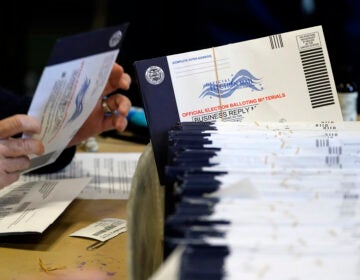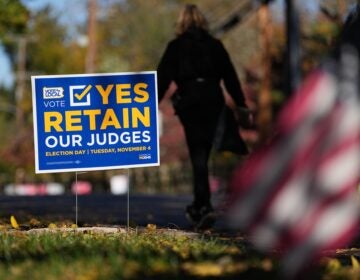Elections 101: Department of State guidance was a 2020 lightning rod. This is how it works
As we approach what’s expected to be another contentious presidential election, here’s what you need to know about directives and guidance.

Secretary of the Commonwealth Al Schmidt in January 2024 at the East Shore Area Library in Harrisburg, Pennsylvania. (Commonwealth Media Services)
This story originally appeared on Spotlight PA.
When legislative Republicans urged Congress to reject Pennsylvania’s electoral votes for Joe Biden in 2020, they didn’t cite voter fraud or illegal activity. Instead, they pointed to something seemingly innocuous: guidance from the Pennsylvania Department of State.
State Republicans including then-state House Speaker Bryan Cutler accused the agency of undermining Pennsylvania’s new mail voting law. Jake Corman, then the state Senate’s majority leader, called on former Secretary Kathy Boockvar to step down, saying, “To have this sort of stuff going on at the 11th hour is unconscionable.”
Corman was referencing guidance issued by Boockvar the day before the November 2020 election that advised counties to notify voters of fatal defects with their mail ballots and have them vote provisionally at a polling place. Some counties followed the guidance, and some didn’t.
Courts did not find merit to the argument that the department had misused its authority, but the narrative that guidance and directives issued late in the election cycle tipped the scales against then-President Donald Trump has persisted on the right since. Republican legislators held a nearly two-hour hearing in 2021 questioning Boockvar about her guidance, and state Sen. Doug Mastriano (R., Franklin) penned an op-ed during his 2022 gubernatorial run claiming that by using guidance, Democrats had “hijacked” Pennsylvania’s mail voting law.
The department regularly issues guidance and directives to clarify election procedures and state law, such as when there is a new court ruling or Election Day problem the agency hopes to avoid repeating.
The two notices hold different weights. Directives carry the force of law based on the secretary of the commonwealth’s authority under the Election Code. Guidances outline the department’s view of best practices that counties should follow.
As we approach what’s expected to be another contentious presidential election, here’s what you need to know about directives and guidance:
What is a directive, and when is it issued?
According to the Pennsylvania Department of State, the secretary issues directives when the Election Code — the law that governs voting in Pennsylvania — specifically gives them authority over that area of election procedure.
This means directives have the force of law; that legal authority is always established at the outset of the directive.
An example of this is a recent directive issued on mail ballots. On July 1, Secretary of the Commonwealth Al Schmidt instructed counties to preprint the full, four-digit year on mail ballot return envelopes.
This was a directive rather than guidance, because the state’s Election Code authorizes the secretary to determine how that return envelope is configured.
What about guidance?
Guidance is issued “whenever it is deemed to be helpful in clarifying rules, procedures, and best practices for the administration of elections,” according to a Pennsylvania Department of State spokesperson.
Guidance often follows a particular problem arising in an election, when a lawsuit sets precedent on some aspect of administration, or when several counties have similar questions about an issue.
For example, during the November 2023 municipal election, some Northampton County voters encountered a troubling error with voting machines due to insufficient pre-election testing. To mitigate the issue on Election Day, some polling places had voters use emergency ballots, but polling places had a limited supply, some of which eventually ran out.
In March of this year, the department updated its guidance to recommend that counties stock emergency ballots at a rate of 20% of a voting precinct’s registered voters.
While guidance may apply to an election process that is required under law, the guidance documents’ specific recommendations on how to perform that process are not mandatory, as former secretary Kathy Boockvar explained in 2021 testimony to the state House. In other words, the department can’t enforce guidance. This leaves counties to decide whether they follow the recommendation.
How will guidance and directives factor into this year’s election?
When the department issues directives or guidance, it notifies all counties and offers training through its Responsive Training Program for County Election Directors.
A department spokesperson said guidance and directives, which can be found on the state government’s website, are “regularly reviewed” for needed updates. More directives or guidances could be issued before the November election.
Schmidt, who was a city commissioner in Philadelphia during the 2020 election, has said he recognizes the frustration that last-minute guidance can cause for election officials and voters.
In response, he has repeatedly said he will not issue new guidance or directives within 45 days of an election, unless a court decision forces the state to do otherwise.
That possibility is not unlikely, as several important cases are now pending in the courts, and state appellate courts have a history of issuing rulings close to Election Day.
 Spotlight PA is an independent, nonpartisan, and nonprofit newsroom producing investigative and public-service journalism that holds the powerful to account and drives positive change in Pennsylvania.
Spotlight PA is an independent, nonpartisan, and nonprofit newsroom producing investigative and public-service journalism that holds the powerful to account and drives positive change in Pennsylvania.

Get daily updates from WHYY News!
WHYY is your source for fact-based, in-depth journalism and information. As a nonprofit organization, we rely on financial support from readers like you. Please give today.





